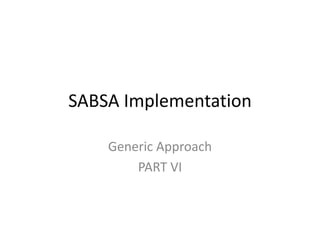
SABSA Implementation(Part VI)_ver1-0
- 2. TIME & PERFORMANCE MANAGEMENT CONCEPTS
- 3. Scope: Strategy & Planning Phase - Time
- 4. Lifecycle Alignment – Demming to SABSA
- 5. Architecture Strategy & Planning Phase
- 7. Implementation Phase & Approach • Implementation is an important part of the lifecycle but the SABSA Matrix does not define a specific implementation layer – No need to re-invent Prince2 or PMI etc. • Notoriously difficult to gain business support and budget for pure infrastructure projects • Rare that a major strategic enterprise-wide security architecture is implemented as a single project • More likely (and more sensible) is that the architecture provides a blue-print and a road-map that guides a whole series of separate implementation projects, each of which is driven by a specific business initiative and funded by a budget associated with that initiative
- 8. Manage & Measure Phase – Lifecycle Overlay • SABSA Architecture traceably abstracts from pure Business Context to: – Pure technical deployment in the Component layer – Pure management in the Service Management layer • The Service Management layer defines all aspects of security management and constructs the means to manage and incorporate change by being presented vertically across the other layers: – Strategy (Context & Concept Layers) – Tactics (Logical, Physical, & Component Layers) – Operations (Security Service Management Matrix)
- 9. Manage & Measure Phase – SSM Matrix
- 11. SABSA Risk Management Process Overview
- 12. Risk Management and the SABSA Matrix
- 13. SABSA Risk Management Activities
- 14. SABSA Lifecycle Domain Risk Perspectives
- 15. Process Improvement Framework – SABSA Maturity Profile (SMP) • Coordinates SABSA process information from all parts of the business – Demonstrates due diligence to senior management, auditors and regulators • Based on Capability Maturity Modelling (CMM) concepts – Qualitative measurement technique for maturity of processes – Six domains mapped onto the SABSA Matrix – Consistent, objective 5-point maturity scale • Identifies, measures and reports compliance practices – Against the SABSA framework, model and processes – Provides a gap analysis to drive a SABSA improvement programme • Can be implemented through a web-enabled tool for – Ease of use, wide involvement, quick responses • Regular use tracks progress and measures changes – Benchmarking against target maturity
- 16. SABSA Maturity Profile Process Areas SMP Process Areas and SMP Process Activities • Each of the six SMP domains is decomposed into six SMP Process Areas • These SMP Process Areas map onto the six cells of the row of the SABSA • Matrix corresponding to the particular SMP domain • The SMP Process Activities are then derived by overlaying the SABSA • Service Management Matrix onto the SMP Process Areas
- 19. Performance Management Framework Defining Business-driven Performance Targets
- 20. Architecture Measurement Categories • Completeness – Do we have all of the components? – Do they form an integrated system? • Assurance – Does the system run smoothly? – Are we assured that it is properly assembled? – Is the system fit-for-purpose? • Compliance – Do we maintain the system? – Do we follow the architecture roadmap – Do we comply with the rules? • Performance – Is the system properly tuned? – Do the components work together? – Do we operate the system correctly? • Justification & significance – Does the system have business value?
- 21. Measurement Approaches • High level statements of the approach to obtaining a measurement • Appropriate to the business need • In the language of the intended audience • Culturally specific
- 22. Measurement Guidelines • Measurement should be a repeatable process (for comparison & prediction) • Measurement should have a clear communications role • Tracking performance • Assigning resources • Measurement should yield quantifiable metrics (percentage, average, numbers, values, etc.)
- 23. Metrics Guidelines • Data used to calculate metrics should be readily obtainable • Metrics may (should) be calculated independently of parties with vested interest • The type of metric used may change in line with the maturity of the security process e.g. when you are highly compliant, consider changing from conformance measure to significance measure • Performance metric / trend should be tested prior to going ‘live’ • Expectations management is key
- 24. Types of Metric • Soft Metrics – Usually qualitative – Subjective – Open to interpretation and opinion (usually of the authority setting the target or of an official compliance agent such as a regulator or auditor) • Hard Metrics – Usually quantitative – Objective – Fixed, not open to opinion or interpretation
- 25. Types of Metric • Descriptive – Describes the current-state of the object / attribute being measured • Comparative – Describes the current-state of the object / attribute being measured in comparison with a similar object / attribute relating to a different place and/or time • Predictive – Describes the current-state of the object / attribute being measured in relation to its trend in order to project and predict afuture state
- 26. Conceptual Measures & Metrics Framework
- 28. END OF PART VI
